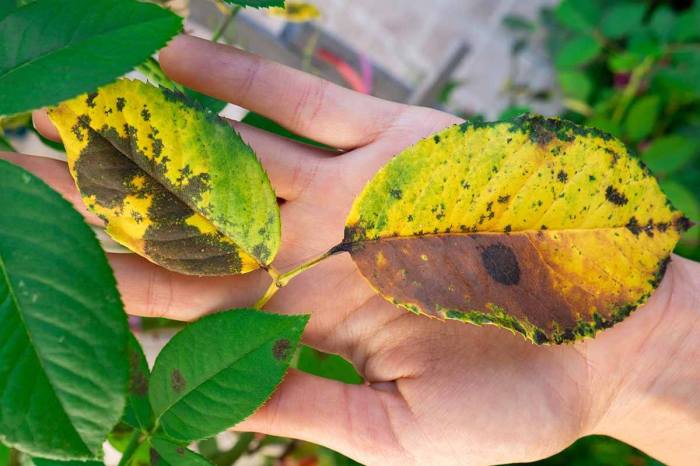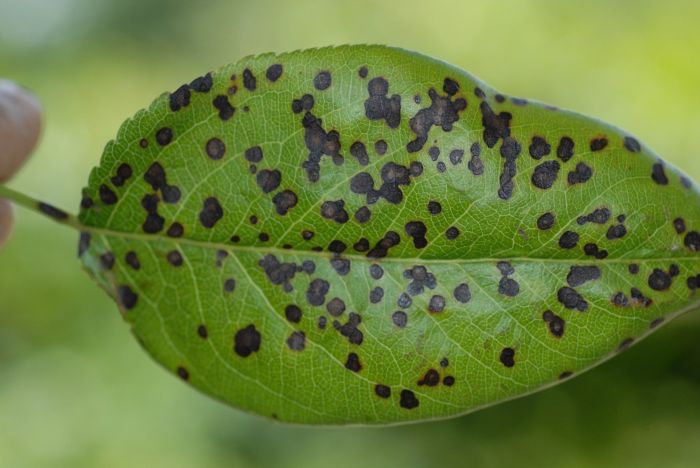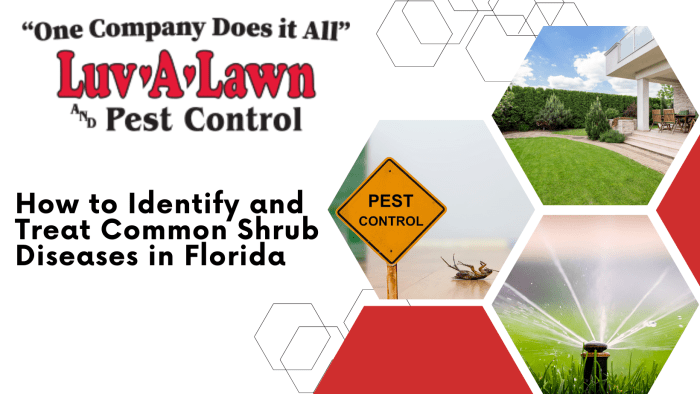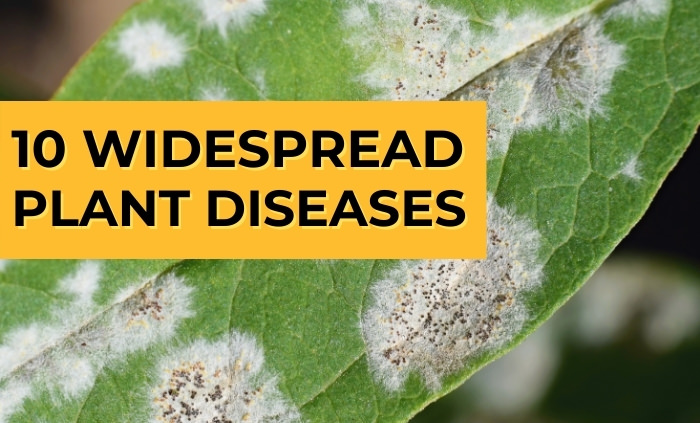Maintaining healthy shrubs requires understanding the common diseases that can affect them. This guide provides a practical approach to identifying and diagnosing nine prevalent shrub diseases, equipping you with the knowledge to effectively address these issues and preserve the beauty and health of your landscape. We’ll explore visual symptoms, environmental factors, and pest interactions to help you accurately pinpoint the problem and select appropriate management strategies.
From recognizing the telltale signs of leaf spot and powdery mildew to understanding the impact of cankers and the role of environmental stress, we will cover a range of diagnostic techniques. We will also delve into effective management strategies, including preventative measures, organic and chemical controls, and the principles of Integrated Pest Management (IPM). By the end, you will have a comprehensive understanding of how to maintain thriving shrubs in your garden.
Identifying Common Shrub Diseases

Visual inspection is the first and often most crucial step in diagnosing shrub diseases. Careful observation of leaves, stems, and overall plant health can provide valuable clues to pinpoint the underlying problem. Recognizing characteristic symptoms allows for timely intervention and prevents the disease from spreading.
Leaf Spot Diseases: Visual Characteristics
Leaf spot diseases manifest as distinct spots or lesions on the foliage. These spots vary in size, shape, color, and margin definition depending on the causal pathogen (fungus or bacteria). For example, Anthracnose, a fungal leaf spot disease, often presents as brown, irregularly shaped spots with a darker border, sometimes accompanied by leaf distortion. Bacterial leaf spots, in contrast, may appear as small, water-soaked lesions that eventually turn brown or black and may have a halo effect. The spots may coalesce, causing large areas of leaf tissue to die. Observing the progression of the spots, their color, and the presence of any accompanying symptoms like leaf drop or wilting can assist in diagnosis.
Differentiating Fungal and Bacterial Leaf Spots
While both fungal and bacterial leaf spots cause discoloration on leaves, there are visual differences. Fungal leaf spots often have a more defined margin and may be accompanied by concentric rings within the spot. The spots might also have a powdery or fuzzy texture due to fungal spore production. Bacterial leaf spots, however, tend to be less defined, appearing more water-soaked initially, and often lacking the concentric rings. They may also have a slightly oily appearance. The presence of oozing from lesions is often indicative of a bacterial infection.
Powdery Mildew: Visual Signs on Shrubs
Powdery mildew is a common fungal disease that creates a characteristic white or grayish powdery coating on leaves, stems, and sometimes flowers. The mildew appears as a superficial layer on the plant surfaces, not penetrating the tissue. Its location varies depending on the shrub type and environmental conditions. It is usually more prevalent on the upper leaf surfaces, but can also affect the undersides and stems. The affected plant parts may appear stunted or distorted, and severe infections can lead to leaf drop.
| Shrub Type | Symptom on Leaves | Symptom on Stems | Overall Plant Appearance |
|---|---|---|---|
| Rose | White powdery coating, mainly on upper leaf surfaces, causing yellowing and leaf distortion | White powdery coating, potentially leading to stem weakening | Stunted growth, reduced flowering, overall unhealthy appearance |
| Hydrangea | White powdery coating on both upper and lower leaf surfaces, potentially leading to leaf curling and browning | White powdery coating, especially on young stems | Reduced flower production, wilting, overall weakened plant |
| Azalea | White powdery coating, initially on young leaves, later spreading to older foliage, causing leaf discoloration and distortion | White powdery coating on young stems and buds | Stunted growth, reduced flowering, potentially leaf drop |
Canker Symptoms on Shrubs
Cankers are localized lesions on stems and branches that result in the death of bark and underlying tissues. They typically appear as sunken, discolored areas on the woody parts of the shrub. The initial appearance of a canker might be a small, slightly discolored patch on the bark. As the disease progresses, the canker enlarges, becoming more sunken and often developing cracks or fissures. The bark in the affected area may die and become dry and brittle. The progression can girdle the stem, disrupting the flow of water and nutrients, eventually leading to the death of the branch or even the entire shrub. The appearance of gummosis (exudation of gum or resin) from the canker is a common symptom in some cases.
Diagnosing Shrub Diseases

Accurately diagnosing shrub diseases requires a comprehensive understanding of the interplay between the plant’s health, environmental factors, and potential pest interactions. Ignoring any of these elements can lead to misdiagnosis and ineffective treatment strategies. This section delves into the crucial role of environmental conditions and pest infestations in disease development, along with practical methods for sample collection and preparation for diagnostic testing.
Environmental Factors Influencing Shrub Disease Development
Environmental conditions significantly influence the susceptibility of shrubs to various diseases. Factors such as temperature, humidity, and soil drainage directly affect pathogen growth and the plant’s ability to defend itself. For example, excessively wet soil, often caused by poor drainage, creates an ideal environment for fungal pathogens like Phytophthora, leading to root rot and wilting. Conversely, prolonged periods of drought stress weaken shrubs, making them more vulnerable to infection by opportunistic pathogens. High humidity favors the development of many fungal leaf diseases, while fluctuating temperatures can stress plants, hindering their immune responses. Optimal temperature and moisture levels, coupled with well-drained soil, are crucial for maintaining shrub health and minimizing disease risk.
Pest Infestations and Their Impact on Shrub Diseases
Pest infestations often exacerbate or even trigger shrub diseases. Insects and mites can physically damage plant tissues, creating entry points for pathogens. For example, aphids feeding on leaves can weaken the plant and leave it susceptible to fungal infections. Similarly, spider mites’ feeding activity can stress the plant, increasing its vulnerability to various diseases. Furthermore, some pests act as vectors, transmitting pathogens from one plant to another. The elm leaf beetle, for example, can transmit the fungus responsible for Dutch elm disease. Effective pest management is therefore crucial for preventing and controlling shrub diseases.
Comparing Symptoms of Diseases Caused by Different Pathogens
Understanding the symptoms associated with different types of pathogens is vital for accurate diagnosis. The following points highlight key differences:
- Fungal Diseases: Often characterized by leaf spots, powdery mildew (a white powdery coating on leaves), cankers (sunken, necrotic areas on stems), and root rot (wilting, stunted growth). Examples include anthracnose (leaf spots and blight), powdery mildew, and various root rots.
- Bacterial Diseases: Typically manifest as wilting, leaf spots (often with a water-soaked appearance), and bacterial ooze (a slimy exudate from infected tissues). Fire blight, a bacterial disease affecting many fruit trees and shrubs, causes rapid wilting and browning of branches.
- Viral Diseases: Often cause mosaic patterns on leaves (mottling), leaf distortion, stunting, and general decline. Viral diseases are usually systemic, meaning they affect the entire plant. Diagnosing viral diseases often requires laboratory testing.
Methods for Sampling Plant Tissue for Disease Diagnosis
Accurate disease diagnosis frequently requires laboratory analysis of plant tissue samples. Proper sample collection and preservation are essential for reliable results.
- Sample Selection: Collect samples from both symptomatic and apparently healthy areas of the shrub. Focus on areas showing characteristic disease symptoms, such as leaf spots, wilting, or cankers. For root diseases, carefully excavate a portion of the root system.
- Sample Size: Collect multiple samples from different parts of the shrub to increase the chance of detecting the pathogen. The size of each sample should be sufficient for laboratory analysis; typically, several leaves, stems, or sections of roots are needed.
- Sample Preservation: Place samples in a clean, sealable plastic bag. Avoid using plastic bags that are not sealed tightly. To prevent fungal growth and maintain sample integrity, some samples might need to be placed in a cooler or refrigerated until testing. For some pathogens, rapid preservation is crucial.
- Sample Labeling: Clearly label each sample with the date, location, plant species, and observed symptoms. This information is critical for accurate identification and diagnosis.
- Sample Transportation: Transport samples to the diagnostic laboratory as quickly as possible to minimize degradation and ensure accurate results. Maintain appropriate temperatures during transport to preserve sample quality.
Management Strategies for Common Shrub Diseases

Effective management of shrub diseases relies on a multi-pronged approach that combines preventative measures with timely interventions. This strategy minimizes disease impact while promoting the long-term health and vitality of your shrubs. A proactive approach is key, focusing on preventing disease establishment rather than solely reacting to outbreaks.
Preventative Measures for Shrub Diseases
Preventing shrub diseases begins with establishing a healthy growing environment and practicing good sanitation. Strong, healthy shrubs are naturally more resistant to disease. Regular monitoring for early signs of disease is also crucial for prompt action.
- Proper Planting and Site Selection: Choosing disease-resistant cultivars and ensuring adequate spacing for good air circulation are essential first steps. Planting in well-drained soil avoids waterlogged conditions that favor many fungal pathogens.
- Watering Practices: Consistent, deep watering encourages strong root systems, enhancing disease resistance. Avoid overhead watering, which promotes fungal spore dispersal.
- Fertilization: Balanced fertilization provides the nutrients necessary for robust growth and disease resistance. Avoid over-fertilization, which can make plants more susceptible to some diseases.
- Sanitation: Removing and disposing of infected leaves, branches, and fallen debris prevents the spread of pathogens. Sterilize pruning tools between cuts to avoid transferring diseases.
Organic and Chemical Control Methods for Shrub Diseases
Organic and chemical control methods offer different approaches to managing established shrub diseases. The choice depends on the severity of the infection, the type of pathogen, and personal preferences. Always follow label instructions carefully when using any control method.
Organic Control Methods: These methods utilize naturally occurring substances to suppress disease. Examples include:
- Neem oil: A natural insecticide and fungicide effective against various pests and diseases. Apply as a foliar spray according to label instructions.
- Copper fungicides: These contain copper compounds that inhibit fungal growth. They are effective against many fungal leaf spots and blights but can be phytotoxic (harmful to plants) if overused.
- Biocontrol agents: Certain microorganisms, like Bacillus subtilis, can suppress fungal pathogens. These are often incorporated into the soil or applied as a foliar spray.
Chemical Control Methods: Chemical fungicides and insecticides provide more targeted and potent control but carry potential risks to the environment and human health. These should be used as a last resort and only after careful consideration.
- Systemic fungicides: These are absorbed by the plant and translocated throughout its tissues, providing broad-spectrum protection. They are effective against many fungal diseases but can impact beneficial organisms.
- Contact fungicides: These act only on the plant surface and are effective against surface-dwelling pathogens. They require more frequent applications and do not provide systemic protection.
Integrated Pest Management (IPM) Strategies for Shrub Diseases
IPM is a holistic approach that integrates various control methods to minimize disease impact while minimizing environmental harm. It emphasizes prevention, monitoring, and the use of least-toxic control options.
The IPM decision-making process can be visualized as a flowchart:
Flowchart:
1. Monitoring: Regularly inspect shrubs for signs of disease.
2. Identification: Identify the specific disease affecting the shrub.
3. Assessment: Determine the severity of the disease infestation.
4. Action Threshold: Compare the severity to an acceptable level of damage. Is intervention necessary?
5. Control Options: If intervention is needed, choose the least toxic and most effective control method (cultural practices, organic controls, chemical controls).
6. Evaluation: Monitor the effectiveness of the chosen control method and adjust the strategy as needed.
Beneficial Organisms for Disease Control
Several beneficial insects and organisms can contribute to disease suppression in the garden.
- Ladybugs (Coccinellidae): These predatory beetles feed on aphids and other sap-sucking insects that can weaken plants and make them more susceptible to diseases. Introduce ladybugs to your garden by purchasing them from a reputable supplier or by creating a habitat that attracts them naturally (e.g., planting flowering plants that attract them).
- Lacewings (Neuroptera): Lacewing larvae are voracious predators of aphids, mites, and other small insects. Similar to ladybugs, you can attract them by planting a variety of flowering plants. Avoid using broad-spectrum insecticides that might harm them.
- Trichoderma fungi: These are beneficial fungi that compete with plant pathogens for resources and produce substances that inhibit their growth. They can be incorporated into the soil to improve overall plant health and disease resistance. Ensure the specific Trichoderma strain is compatible with the plants and pathogens in your garden.
Ultimate Conclusion

Successfully identifying and managing shrub diseases requires a combination of keen observation, understanding of environmental influences, and appropriate treatment strategies. By carefully examining visual symptoms, considering environmental factors, and employing integrated pest management principles, you can effectively protect your shrubs from disease and ensure their long-term health and vibrancy. Remember, early detection and prompt action are crucial for minimizing damage and maintaining the beauty of your landscape.